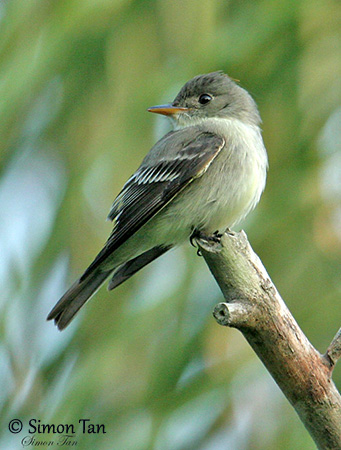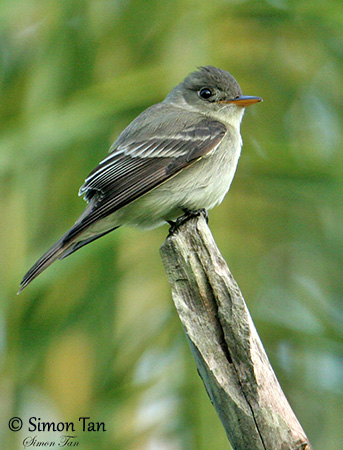
Fr: Pioui de l'Est
Ang: Eastern Wood-Pewee
All: Hellbauch-Schnäppertyrann
Esp: Pibí Oriental
Ita: Piuì boschereccio orientale
Nd: Oostelijke Bospiewie
Sd: östlig pivi
Photographers:
Jean Michel Fenerole
Photos d’Oiseaux du monde
Jean-Claude Jamoulle
A la rencontre des Oiseaux
Simon Tan
PBase Bird galleries
Text by Nicole Bouglouan
Sources:
HANDBOOK OF THE BIRDS OF THE WORLD Vol 9 - by Josep del Hoyo - Andrew Elliot - David Christie - Lynx Edicions - ISBN: 8487334695
FIELD GUIDE TO THE BIRDS OF NORTH AMERICA - National Geographic Society - ISBN: 0792274512
Houston Audubon Society (National Audubon Society)
Animal Diversity Web (University of Michigan Museum of Zoology)
Tennessee Wildlife Resources Agency
MISSOURI DEPARTMENT OF CONSERVATION
Wikipedia, the free encyclopaedia
Eastern Wood-Pewee
Contopus virens
Passeriformes Order – Tyrannidae Family
INTRODUCTION:
The range of the Eastern Wood-Pewee extends from Regina (Saskatchewan) to Sinop (Brazil), and globally from eastern North America S into South America where it spends the winter.
As its name suggests, the Eastern Wood-Pewee is a bird of woodlands, and mainly deciduous woodlands. It breeds in forests but it winters at forest edges.
It feeds primarily on insects, but it also takes other arthropods and occasionally berries and seeds.
It nests in trees in a compact open cup. Both parents feed the chicks.
This species belongs to the subfamily FLUVICOLINAE in the large family Tyrannidae.
The Eastern Wood-Pewee is fairly common but the population is suspected to be slowly declining. However, the species is not globally threatened at the moment.

DESCRIPTION OF THE BIRD:
Biometrics:
Length: 15 cm
Wingspan: 23-26 cm
Weight: 14 g
The Eastern Wood-Pewee is a medium-sized flycatcher with long wings and tail. The short legs give it an upright posture, whereas the head has triangular shape caused by the peaked crown.
The upperparts are greyish and the upperwing shows two white and dark grey wingbars. The wings are darker than the rest of the upperparts. The tail is dark grey.
The underparts are whitish with little to no yellow. The breast sides are dark, but chin, throat, belly, vent and undertail-coverts are white. Both underwing and undertail are greyish.
The Eastern Wood-Pewee shows the characteristic greyish “vest” typical of pewees.
The head is grey. The triangular shape is caused by the peaked crown. Chin, throat and lower cheek are whitish.
The two-tone bill has dark brown to black upper mandible, whereas the lower mandible is pale orange-yellow with dark tip. The eyes are dark brown. Legs and feet are dark brown to black.
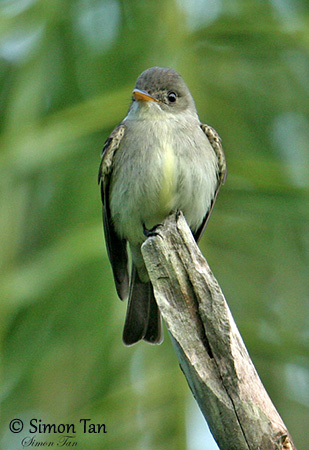
Male and female have similar appearance.
The juvenile is darker throughout upperparts feathers showing cinnamon/brown fringes and wingbars. The underparts are yellower.
The chick is covered in dull down with white feather bases.
RANGE:
The Eastern Wood-Pewee breeds in E North America, in the southern parts of Saskatchewan, Manitoba, Ontario, Quebec and the Maritime Provinces.
In the United States, the range extends into the eastern states to Texas, and also east along the Atlantic coast.
It migrates to South America to spend the winter, passing though eastern Mexico and Central America. It does not cross the Gulf of Mexico.
It winters in N South America, in parts of Colombia, Venezuela, Peru, Bolivia and Brazil.
HABITAT:
The Eastern Wood-Pewee breeds in mature and intermediate mixed-species forests, generally with large trees and sparse underground. It prefers deciduous trees and can be found in upper or lower canopy. But it also may breed in orchards, roadside-trees and also in urban savannas and riparian habitats.
While migrating, the Eastern Wood-Pewee frequents habitats with trees and shrubs, edges, clearings, primary and secondary forests.
During the winter, it is usually observed in wooded or partially cleared habitats, including shrubby areas, and generally below 1,300 metres of elevation.
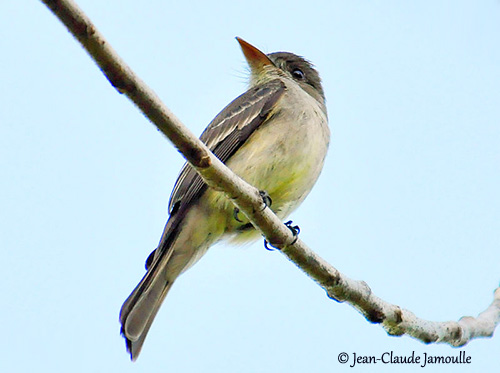
CALLS AND SONGS: SOUNDS BY XENO-CANTO
The Eastern Wood-Pewee gives a plaintive “pee-ah-weee” or “pee-weee” falling in pitch at the end. This sound gives the bird its name.
It is usually most active by day, but it may also sing at night. It begins to sing up to 45 minutes before sunrise, and then, it continues throughout the day.
The call is a loud, dry “chip plit” and clear, whistled, rising “pawee” notes given together “plit-pawee”.
The female does not sing. However, the pairs may occasionally sing duets through July into early August.
In aggressive behaviour near the nest, the Eastern Wood-Pewee performs bill-snapping directed towards intruders.
BEHAVIOUR IN THE WILD:
The Eastern Wood-Pewee is primarily an insect-eater. It catches flying insects from perches in the subcanopy, about 10-12 metres above the ground.
It consumes several insect species including flies, true bugs (Hemiptera), butterflies and moths, beetles, grasshoppers, stoneflies and mayflies. It may occasionally take spiders and dragonflies, as well as berries and seeds.
Insects are caught on the wing or by gleaning off vegetation or ground.
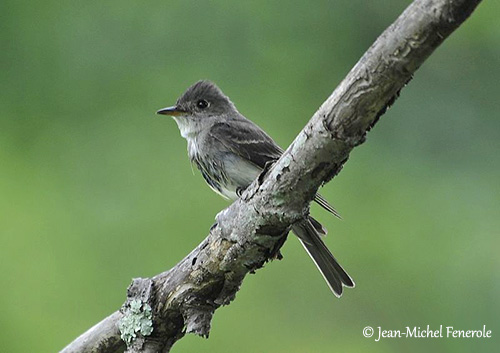
The Eastern Wood-Pewee is monogamous, with some cases of polygyny. The courtship displays are poorly known, but sexual chases have been reported. The male may also perform courtship feeding to the female.
The male defends the nesting territory by singing in spring, especially at dawn and dusk.
The nest-site is often in deciduous trees. The female builds the nest and incubates alone, but both parents feed the chicks.
The Eastern Wood-Pewee is a long-distance migrant. It moves between its breeding range in North America through eastern Mexico and Central America, to reach the wintering grounds in South America, as far south as Sinop, Brazil.
The fall migration begins mid to late August, with peak in early to mid-September.
The Eastern Wood-Pewee is a late spring migrant. It appears first in extreme southern United States early to mid-April. It is common throughout its breeding range early to mid-May.
It migrates probably at night and usually solitary.
This species has a weak, fluttering flight with shallow wingbeats. While foraging, it performs acrobatic aerial manoeuvres after flying insects.
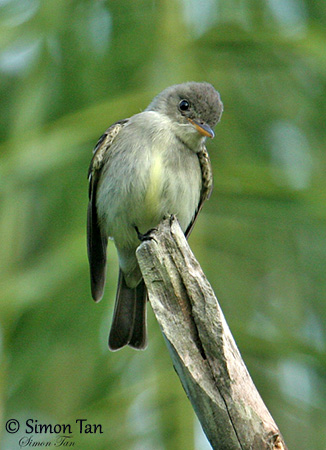
REPRODUCTION OF THIS SPECIES:
The breeding season usually takes place between May through August, with peaks during early June and mid-July. The male sings to defend the nesting territory.
The nest is built in deciduous tree, probably by the female alone. The nest is a compact, open cup made of grass, plant fibres and spider webs. Some lichens are seen outside. The cup is lined with soft materials such as hair, grass, moss, lichens and vegetal fibres.
Such nest appears very small and looks like a bump or a knot on a branch. It may be reused for the second brood of the season.
The female lays 2-3 (rarely 4) whitish eggs with darker blotches on the larger end. She incubates alone during 12-13 days.
The chicks are fed by both parents, and fledge about 16-18 days after hatching.
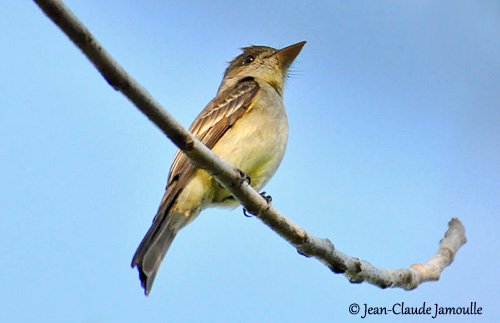
PROTECTION / THREATS / STATUS:
The Eastern Wood-Pewee is fairly common throughout the range, but the population is suspected to be declining by approximately 1% per year.
This species is tolerant of forest fragmentation, but the White-tailed Deer may cause changes to the intermediate canopy where the birds are often foraging.
Other threats may include pesticides affecting their prey, and collisions with buildings.
The global population is estimated at 6,500,000 mature individuals.
The Eastern Wood-Pewee is not considered globally threatened, and the species is currently evaluated as Least Concern.
